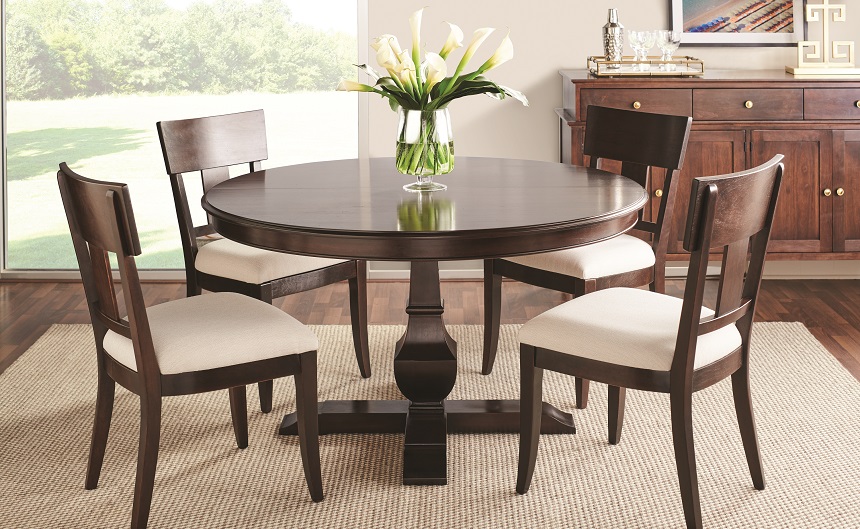‘Comfort’ translates to more in casual dining

“Customers are still spending time at home, more than ever,” said Cindy Hall, Sherrill Furniture vice president of case goods merchandising. “We’ve all become more of a ‘home-body.’ There are still a lot of Americans working from home, and this is unlikely to change. Dining rooms often double as a ‘office’ space during the day, a ‘dining’ room for dinner and sometimes even transition back to a ‘desk’ for homework/late-night work after dinner.
“I think our desire to be comfortable can be found from casual clothing to casual furniture,” she continued. “We are just trying to be more relaxed since the world around us seems unstable. Home is a haven and comfort for us all.”
Sherrill and its sister companies, which include Hickory White and Lillian August, offer an array of dining room chairs and tables. Hall said the category remains strong, particularly in the higher end.
“Casual is important, but the desire to have a formal dining is still there,” she said. “I don’t think customers are wanting matching sets, but they want timeless pieces that are classic in nature and can be curated to create a cozy warm area.”
Hall speculated that there are probably more small intimate dining gatherings now vs. prior to COVID-19, with people choosing to keep close friends and family even closer instead of meeting at crowded restaurants.
“I think we will see the casual category continue to develop even in the higher-end, which has typically been more formal,” she noted. “The desire to be at home will likely continue through 2022 and beyond.”
Affordable solutions
Najarian Furniture, which offers several dining collections and stand-alone dining tables, chairs, servers, bars and curios, also says the category is strong.
“I would say we’re seeing sales remain strong in this category as consumers are still looking at affordable solutions to update their dining areas,” said Michael Lawrence, company vice president. Lawrence said customers are looking for lower cost with style.
“Lower cost allows the consumer to try a fresh style or trend without a huge monetary commitment,” he says. “Additionally, in many parts of the country where homes are smaller or for people living in condos and apartments, the smaller scale of casual dining simply fits their homes better.
“For us the casual dining category is dominated by our glass top and pedestal base with an eclectic mix of side chairs.”
Lawrence believes there’s plenty of life left in formal dining. “As a company we’ve done extremely well for a while now in the formal dining category. A lot of our styles simply translate well into larger tables and scaled-up chairs and nicely accented bars and servers. So, yes, you definitely still have a consumer out there in homes with formal dining spaces that have a need for tables that can seat six to 10 people.”
When asked about the future of the category, Lawrence advised suppliers to stay on-trend with designs at competitive or opening price points.
Gat Creek offers several dining room collections, primarily in the upper and middle price ranges. Like Sherrill and Najarian, company President Gat Caperton said business and demand remain elevated, but he thinks differently about the balance between casual and formal dining.
“Casual dining is continuing to be strong after the pandemic because it continues to take share from formal dining,” Caperton said. “The new housing rate also remains strong. Plenty of formal dining rooms exist, but few new ones are being built. Casual will continue to gain share over formal.”
He sees the casual dining category growing well into the future, much of which will be fueled by a desire to upgrade old furniture.
“More and more people prefer eating somewhere between their refrigerator and their TV as opposed to a rectangular room off to the side,” Caperton said. “Old furniture does not often fit the space.”
Multiple lifestyles
Home furnishings resource Parker House said open floor plan home design and the surge in home renovation are what’s pushing the category forward.
“As families have returned to dining together as a form of connection, the need for flexible, comfortable dining furniture has re-emerged,” said Marietta Willey, vice president of product development and merchandising. “This lifestyle direction continues to be driven and supported by the ongoing popularity of the modern farmhouse aesthetic and DIY home renovation and restoration.
“Open floorplan home design — where cooking, eating and entertaining are central — is also fueling the growth of the dining category.” Willey said Parker House has found a way to combine the casual and formal dining styles together.
“Our focus is on what we call ‘Grand Casual Dining,’” said Willey. “This category spans multiple styles and collections and is designed to address today’s lifestyles by delivering a look that is fashionable yet not overly formal. Offered in a wide array of finishes, our Grand Casual Dining furnishings encompass classic styling, innovative features and fresh finishes that blend with existing furniture.”
Willey said customers want counter-height designs, including tables, islands, entertainment bars and stools. They also want multi-functional surfaces, integrated lighting and better-placed power outlets. Both aesthetic and functionality are important.
“I think the growth in the casual dining category will be in creating collections that complement today’s lifestyles in both aesthetic and functionality,” she added. “We will continue to focus on fashionable finishes, hardware and styling, as well as flexible designs that let consumers personalize their look with multiple chair options and a choice of coordinating storage pieces.”
